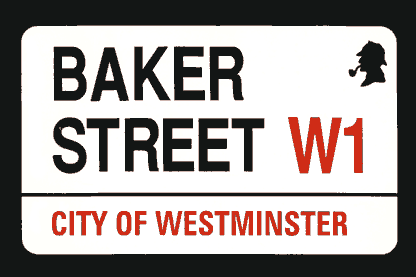|
Street signs on
Baker Street, Westminster
|
As a Halloween costume, it's almost too easy–just
wear a deerstalker cap, stick a calabash pipe between your teeth,
and carry a magnifying glass. Say, "Elementary, my dear Watson."
Chances are, everyone will know that you're supposed to be Sherlock
Holmes. No matter that Holmes wore a cap only once in the original
stories, that his pipe of choice was not a calabash, and that he
never uttered that phrase. He did, however, use a magnifying glass
occasionally.
Like other pop culture icons, Holmes and Watson have evolved since
their creation over a century ago. Their characters have changed,
as have the qualities for which audiences admire them. Below appear
some of the best-known permutations of Holmes and Watson, as they
have traveled from print to stage and radio, to film and television,
and back to print again. It would be impossible to list every version
here, so some guidelines have been included for further investigation.
The game is afoot! Happy sleuthing.
The Many Faces of Holmes
The original readers of the very first Holmes story, A Study
in Scarlet, had to do with four lackluster illustrations by
D.H. Friston, but, when the novella was published in book form,
Holmes looked something like Arthur Conan Doyle's own father, Charles
Altamont Doyle–and was, in fact, the elder Doyle's creation. The
author's father created a series of vague line-drawings that unfortunately
failed to capture the excitement of the text. He gave Sherlock Holmes
his own features, including his scraggly beard. No record exists
of his son's response.
|
Holmes and Watson
on the town |
When "A Scandal in Bohemia" was published in The
Strand Magazine in 1891, readers were greeted with Sidney Paget's
moody drawings, which represent Holmes as tall, handsome, and elegant,
despite Conan Doyle's original description, according to which Holmes
was extremely thin, with a large nose and small eyes set close together.
Apparently Paget's younger brother Walter, whom the artist used
as a model, was quite a handsome fellow. Years later, after his
brother's death, Walter himself illustrated a few of Conan Doyle's
stories in The Strand.
Conan Doyle soon grew attached to Sidney Paget's elegant vision
of Holmes, and when he met the American actor William Gillette,
who wanted to play Holmes on the stage, he felt that his creation
had come to life. Pictures of Gillette as Holmes, wearing the famous
dressing gown, can be found at the "221B Baker Street" website (ed.
Sherry Franklin): www.sherylfranklin.com/sh-gillette.html.
|








